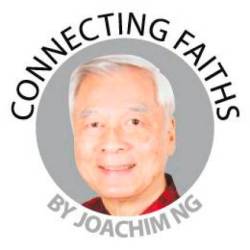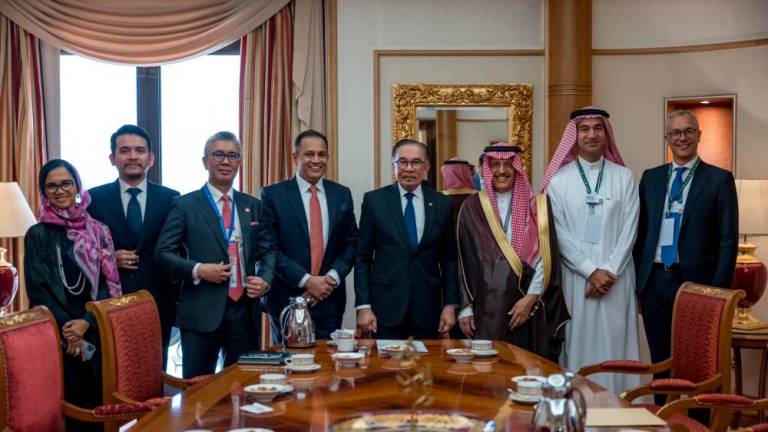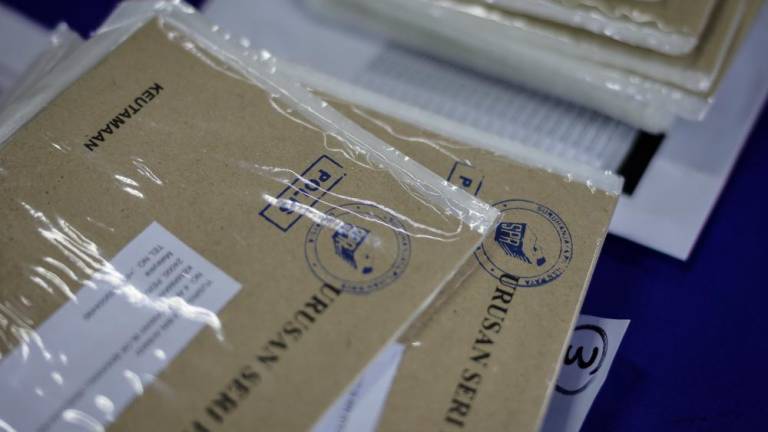THE KK Mart socks incident that culminated in the throwing of three Molotov cocktail firebombs should have spurred leaders of all non-Muslim religions to jointly play a counselling role alongside Muslim organisations at the initial stage, and hence, transform the situation into an opportunity to foster better inter-communal understanding.
Interfaith organisations such as the Malaysian Consultative Council for Buddhism, Christianity, Hinduism, Sikhism and Taoism (MCCBCHST) should adopt a proactive approach and speedily undertake on-the-ground service work whenever ethnic or religious tensions surface.
The occasional interfaith forum or seminar featuring representatives from various religions talking about the good points of their respective faiths is a long outdated style. It has no impact on society. Our religious leaders and the National Unity Ministry should do more during the month of World Interfaith Harmony Week, as currently no significant grassroots programmes are conducted.
Some non-governmental organisations (NGOs) that aim to be peacebuilders have also shied away from the task and now focus on charity work rather than exploring solutions to inter-communal problems besetting our nation.
The socks incident and the ensuing bitterness that kept spiralling upwards ought to serve as a wake-up call to the National Unity Ministry and all NGOs with a public service goal that their top priority must be to establish nationwide reconciliation.
In recent years, such NGOs have narrowed their scope to serving fragments of society rather than adopting a whole-of-society approach.
Religious groups also seem to have lost their grand vision or have abandoned whatever broad vision they used to hold dear. All have forgotten this all-important verse in the Book of Proverbs addressed to an entire nation: “Where there is no vision, the people cast off restraint and run wild.”
Religious organisations should break out of the parochial focus on teaching their faiths only and embrace a divine vision of multicultural and multifaith unity to hold the nation tightly together. They must strive to work collaboratively and undertake service to the public in all matters that affect national unity.
King Abdullah II of Jordan and his late father King Hussein are widely acknowledged as world leaders who initiated the interfaith era for humanity. In 2006, King Abdullah was invited to address a large evangelical Christian audience at a national prayer breakfast in Washington and he called upon people of all faiths to discard the idea of a clash of civilisations.
It was he who introduced the World Interfaith Harmony Week at the 65th United Nations General Assembly in 2010. On that memorable occasion, he told the plenary session: “It is essential to resist forces of division that spread misunderstanding and mistrust, especially among peoples of different religions. The fact is, humanity everywhere is bound together, not only by mutual interests but by shared commandments to love God and neighbour, to love the good and neighbour.”
Yet in Malaysia, nobody follows his initiative fully despite such harmful incidents as the socks debacle and similar potentially inflammable but fortunately rare incidents such as the occasional destruction of temple stone images by misguided vandals.
After KK Mart had issued an apology, an interfaith team from MCCBCHST and perhaps with the inclusion of the smaller but more tightly-knit Interfaith Spiritual Fellowship should have visited the directors soonest possible and advised them to make atonement through an act of sacrifice taught by all religions.
The sacrifice could be in the form of several thousand ringgit worth of halal food packs donated to various mosque committees for distribution to poor Muslim families. KK Mart could even pledge to distribute halal food packs every Ramadan.
In view of the escalation into bomb-throwing, this is a fit occasion to explain the practice of sacrifice. The trail leads from human sacrifice to animal sacrifice, to sacrifice in the form of charity and finally back to human sacrifice in a completely transformed manner – the most efficacious sacrifice with high relevance to Malaysia’s political situation.
The notion of sacrifice arose from observation of nature in ancient times. For instance, the scarlet worm dies soon after giving birth so that the larvae may feed on her body for nourishment. This is self-sacrifice for the sake of new life.
The octopus, squid, salmon, common mayfly, praying mantis, spider, scorpion and aphid are among many other species where it has been observed that mothers die soon after birth – often to feed predators who then refrain from eating the newborn.
Humans imitated the sacrificial character of nature by inventing the practice of child sacrifice, and it became standard practice in the early days of all ancient civilisations.
In 2020, archaeologists in China excavated a human skeleton in a sacrificial pit dating back to the Shang Dynasty around 3,600 years ago. The skeleton was found in a kneeling position with both hands crossed in front. The sacrificial person had been beheaded.
In 2018, archaeologists in Peru found evidence of the biggest-ever human sacrifice, uncovering the remains of more than 140 children who were slain in a sacred ritual at the time of the Chimu civilisation. More than 20 years earlier, archaeologists had found a well-preserved mummy of an Inca maiden, no older than 15 years, who was sacrificed by a blow to the head.
In pre-Roman times, child sacrifice was prevalent throughout Western Europe. Some 15 years ago, archaeologists found evidence of a young, healthy and strong man whose body was painted in mysterious symbols being sacrificed by having his head clubbed and throat slit. He was a hero of the druids in Britain who were fighting to ward off the Roman invaders. The druids had sacrificed him as an offering to God to fight alongside them.
Child sacrifice was equally prevalent in West Asia including the Holy Land. The Torah describes child sacrifice by Canaanites and Israelites. In the second book of Kings, the King of Moab took his eldest son and offered him a burnt offering after a battle with the Israelites. In the book of Judges, an Israelite commander-in-chief defeated the Ammonites and in thanksgiving to God he made a burnt offering of his daughter who was his only child.
As civilisations grew aware of human rights, an offering of the best animals and farm produce was devised to substitute for child sacrifice. The food was then consumed – by humans, of course.
This switch to a substitutionary sacrifice was dramatised in a chilling story about an ancient patriarch Abraham and his son. Abraham took his son Isaac on a journey up a mountain, built an altar, laid his son on it and placed a bundle of chopped wood to make a burnt offering of the boy. Just as he was about to slay his son with a knife, he stopped, looked around and spotted a ram caught in a thicket. He burnt the ram instead.
This epic drama symbolised the abandonment of child sacrifice by civilisations.
Animal slaughter in sacrificial rituals became the vogue and remains the favourite to this day. The livestock animals picked to give their lives are preferably sheep, cattle, goats, pigs and chickens.
Fruits and vegetables are also placed on altars. However, awareness of animal rights and environmental destruction is leading to growing revulsion over the forced slaughter of innocent lives.
Bear in mind that the main purpose of sacrifice is reconciliation: to re-establish a broken link or to mend a damaged relationship, and also to influence higher powers to work in your favour. Thus, in any incident wherein a relationship with one community has been damaged, the distribution of food packs to poor members of that community is the most suitable form of reconciliation.
Two religions indigenous to India, Hinduism and Sikhism, have long traced the cause of all broken or damaged relationships to one root cause: human ego. These two religions have transmuted the ritual into the loftiest form of sacrifice – the sacrifice of ego.
Known as purusayajna in Sanskrit, or the sacrifice of collective humanity, the call is to sacrifice biasness, selfish gain and parochialism. Instead, practise non-attachment, sacrifice of self and communal exclusivity, and embrace a whole identity.
Purusayajna contains a lesson for many politicians around the world whose favourite indulgence is to garner selfish gain for power, sacrifice national interests for party advancement and aggravate tensions to widen their grip on traditional voter bases.
The Sikh scripture, Sri Guru Granth Sahib, is hard-hitting. Here is a short list of powerful verses: “Everyone worships God while abiding in ego, and so, one’s mind is saturated not with God, nor one gathers peace. One utters prayers to gratify one’s ego, and so wastes away one’s life, and one’s dedication avails not.
“Where there is avarice, there is death and where there is forgiveness, there is God himself. Of what avail is the abandonment of maya, if man abandons not his self-conceit? Ego destroys all one’s merit. Ego eats all up.
“Power breeds ego and pride must have a fall. He who is alive to his ego dies, and he who is dead to his ego becomes eternal. I indulge in self-esteem, and egoistic is my speech. He alone attains to the gate of salvation who stills his ego from within himself.
“The ego has burnt down the whole world.”
The writer champions interfaith harmony.
Comments: letters@thesundaily.com











